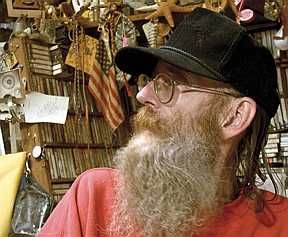In many ways the 56-year-old local artist Bill
Snyder provides the dictionary definition of
He hasn’t had a public showing of his works for
at least two years, the last being an appearance
at David Krouse’s 1911 Gallery during a Trolley
Tour and a Dash-In exhibit shared with Diane
Gronert. Yet the mention of his name amongst the
local art illuminati brings immediate and
enthusiastic recognition.
It’s not clear that one could locate his address
via Mapquest (Orff Avenue?) or even with a GPS
device. He has shown agoraphobic tendencies and
has been sequestered for some 30 years in a
100-year-old wooden-framed house/studio that he
shares with his wife/muse, Judie Panock, on the
city’s near west side. It’s there they’ve raised
their four children; three have left the nest and
the fourth, Scott, is attending IFPW.
Born the oldest of 11 children in Decatur,
Snyder spent the first two years after high
school with the U.S. Army where, attached to the
Signal Corps, he provided synapse between
landline and radio communication in Germany.
Following his military service he spent time at
the Fort Wayne Art Institute then found work as a
painter with BZW Master Painters, where he has
been for the last quarter-century-plus.
(Ironically, the ceilings in this century-old
domicile have never been painted since the couple
moved in, but now the walls and trim are
currently being revisited by Judie, who teaches
Special Education classes and is currently
working on her Master’s at the University of Saint
Francis.)
To get to Snyder means to go through Judie.
During this interview Snyder would halt or stall
the questioning until his wife could re-enter the
room; you can’t have one without the other.
Snyder needs no coaching when called upon to
cite his visual inspirations and influences.
Among his favorites are Picasso, Gorky, Klee,
Matisse, Rivers, Johns, Warhol and Diebenkorn.
His music – a medium that serves as his comfort
food (his studio walls are lined with hundreds of
cassette tapes and CDs) – includes an eclectic
array of artists, among them Miles Davis,
Thelonious Monk, Los Lobos, Tom Waits, Glenn
Miller, Bill Evans and Mel Torme (many of the
classics he remembers from his mothers record
collection).
As to literary influences Snyder is partial to
many writers like the German poet Ranier Maria
Rilke, the French playwright Jean Genet and Irish
writer James Joyce, among dozens of others.
In other words, as Snyder would say, “I’m drawn
to all the great creations, those one-of-a-kind,
ages-enduring pieces that can never be
reproduced. Some would say ‘classics’ but those
lists are often different from mine.
“Only in recent times have I been able to
revisit some of my favorite writers that I
glossed over in my youth.”
To examine Snyder’s work is to assume a
challenge that is taxing, thought provoking and
risky, but ultimately rewarding.
There are the paintings, prints and collages
that form the earliest part of the arc of the
artist’s 35-year spectrum of work. These early
efforts have accumulated local and regional
awards and earned him exhibits in Chicago
galleries. They comprise testament to an
unrefined, yet teeming mind and talent. But to
evoke the current Snyder at, I think, his best,
one needs to focus upon his extraordinary
drawings. Those inch-and-a-half thick, 11-by-14,
coil-bound, gel pen-inscribed folios of optical
illusionary, labyrinthine, rhythmic
representations that both give clues and
disguises as to what Snyder is about.
Each individual piece (suitable for framing) can
be best appreciated in their magnitude by
flipping the pages and admiring the differences,
each rendering signifying a distinct theme and
message.
Abstract for sure, the artist’s works are
difficult to decipher. Intricate, precise and
mostly geometric, they suggest a controlled hand
guided and inspired by powers unnamed. In some
cases they appear maze-like, tracing paths that
are concentric but lead only to another beginning
point. Impossible, chimerical in form, they also
suggest linear scriptural overtones (M.C. Escher
meets the crop circle gang).
Patterns emerge (think Batik) but only within
each individual piece, not overall.
Snyder’s admitted affection for music can be
detected in these works. An admirer of John Cage,
among other 60s icons, it is easy to see the
influence of chance and musical notation
vis-ý-vis the visual beauty of George Crumb’s
scores.
Friend and fellow artist David Krouse remembers
a not-too-long-ago episode visiting Snyder while
he was working in his studio:
“It was a moment filled with meaning for me when
I walked in and Bill was tossing some dice upon
which he had affixed different colors on the
faces … and he was using them to divine the
next color he would incorporate in the piece he
was working on. It was an eye-opener for me and a
kind of epiphany I continue to use.”
Snyder admits that color choices are
troublesome. Psychedelic versus the austere,
ascetic realm. He lives most comfortably in an
achromatic universe. It’s an environment that he
finds rigorous and elegant at the same time. It
allows for his innocence while underlining his
maturity.
Perhaps, after all, he’s a composer, scoring the
resonant vibrations he’s attuned to, leaving it
for us to sing along.
To join the chorus one can reach Judie and Bill
judiepanoch@hotmail.com.
 Submit Your Event
Submit Your Event
